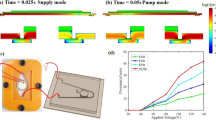Abstract
Microinjection moulding is an essential technology for mass production of components with micro-features. In addition, it can integrate multiple parts into a single piece, thus reducing the number of parts and removing assembly processes. An ortho-planar spring, a typical example of a micro-compliant mechanism, is a monolithic structure and contains a base body, multiple curved micro-beams as flexible members, and a moving platform in an out-of-plane direction as an end-effector. Owing to its complex layout, including micro-structures with a high-aspect-ratio, to the best of our knowledge, an injection moulding approach applied to the ortho-planar spring has never been previously reported. In this study, the ortho-planar spring usable in various micro-systems, is fabricated by the microinjection moulding of polyoxymethylene. Two springs, based on the same four-leg designs but with different leg dimensions, were arranged in a two-cavity mould that is equipped with a dynamic mould temperature control unit. A basic flow pattern in micro-cavities was observed from the partially filled moulded parts. In the cavity with the small leg dimension, a high-cavity pressure causes severe flashes at the parting plane, thus failing to fill the cavity completely. Mould temperature, holding pressure, and injection speed, were chosen as the process parameters for design of experiment (DOE) and analysis of variance (ANOVA) to allow identification of the significant parameters. Finally, the spring constant of the completely replicated ortho-planar micro-springs were measured and compared with the FEA results.










Similar content being viewed by others
References
Ananthasuresh GK (2013) How far are compliant mechanisms from rigid-body mechanisms and stiff structures? Adv Mech Robot Des Educ Res Mech Mach Sci 14:83–94
Attia UM, Marson S, Alcock JR (2009) Micro-injection moulding of polymer microfluidic devices. Microfluid Nanofluid 7(1):1–28
Despa MS, Kelly KW, Collier JR (1999) Injection molding of polymeric LIGA HARMs. Microsyst Technol 6(2):60–66
Giboz J, Copponnex T, Mélé P (2007) Microinjection molding of thermoplastic polymers: a review. J Micromech Microeng 17(6):R96
Greener J, Wimberger-Friedl R (2006) Precision injection molding. Carl Hanser, Munich
Hayes G, Frecker M, Adair J (2011) Fabrication of compliant mechanisms on the mesoscale. Mech Sci 2(1):129–137
Heckele M, Schomburg WK (2004) Review on micro molding of thermoplastic polymers. J Micromech Microeng 14(3):R1
Howell LL (2001) Compliant mechanisms. Wiley, New York
Judy JW, Muller S (1997) Magnetically actuated, addressable microstructures. J Microelectromech Syst 6:249–256
Kim WW, Gang MG, Min BK, Kim WB (2014) Experimental and numerical investigations of cavity filling process in injection moulding for microcantilever structures. Int J Adv Manuf Technol 75(1–4):293–304
Leo V, Cuvelliez C (1996) The effect of the packing parameters, gate geometry, and mold elasticity on the final dimensions of a molded part. Polym Eng Sci 36(15):1961–1971
Li B, Chen Q (2005) Design and fabrication of in situ UV-LIGA assembled robust nickel micro check valves for compact hydraulic actuators. J Micromech Microeng 15:1864–1871
Lobontiu N (2002) Compliant mechanisms: design of flexure hinges. CRC Press, Roca Raton
Lucchetta G, Sorgato M, Carmignato S, Savio E (2014) Investigating the technological limits of micro-injection molding in replicating high aspect ratio micro-structured surfaces. CIRP Ann Manuf Technol 63(1):521–524
Nguyen NT, Truong TQ, Wong KK, Ho SS, Low CLN (2004) Micro check valves for integration into polymeric microfluidic devices. J Micromech Microeng 14(1):69–75
Osswald TA, Baur E, Brinkmann S, Oberbach K, Schmachtenberg E (2006) International plastic handbook. Carl Hanser, Munich
Parise JJ, Howell LL, Magleby SP (2001) Ortho-planar linear-motion springs. Mech Mach Theory 36(11):1281–1299
Piotter V, Mueller K, Plewa K, Ruprecht R, Hausselt J (2002) Performance and simulation of thermoplastic micro injection molding. Microsyst Technol 8(6):387–390
Seidemann V, Rabe J, Feldmann M, Büttgenbach S (2002) SU8-micromechanical structures with in situ fabricated movable parts. Microsyst Technol 8(4–5):348–350
Seong M, Mohanchandra KP, Lin Y, Carman GP (2008) Development of a ‘bi-layer lift-off’ method for high flow rate and high frequency Nitinol MEMS valve fabrication. J Micromech Microeng 18:075034
Sha B, Dimov S, Griffiths C, Packianather MS (2007) Micro-injection moulding: factors affecting the achievable aspect ratios. Int J Adv Manuf Technol 33(1–2):147–156
Smal O, Raucent B, Ceyssens F, Puers R, De Volder M, Reynaerts D (2008) Design and testing of an ortho-planar micro-valve. In: Ratchev S, Koelemeijer S (eds) IFIP International Federation for Information Processing, vol 260. Micro-Assembly Technologies and Applications. Springer, Boston, pp 75–86
Sun X, Chen W, Tian Y, Fatikow S, Zhou R, Zhang J, Mikczinski M (2013) A novel flexure-based microgripper with double amplification mechanisms for micro/nano manipulation. Rev Sci Instrum 84(8):085002
Teichert GH, Jensen BD (2013) Design and fabrication of a fully-compliant mechanism for control of cellular injection arrays. Prod Eng 7(5):561–568
Teichert GH, Burnett S, Jensen BD (2013) A microneedle array able to inject tens of thousands of cells simultaneously. J Micromech Microeng 23(9):095003
Wang PH, Dai XH, Fang DM, Zhao XL (2007) Design, fabrication and performance of a new vibration-based electromagnetic micro-power generator. Microelectron J 38(12):1175–1180
Xu G, Yu L, Lee LJ, Koelling KW (2005) Experimental and numerical studies of injection molding with microfeatures. Polym Eng Sci 45(6):866–875
Yang C, Li L, Huang H, Castro JM, Yi AY (2010) Replication characterization of microribs fabricated by combining ultraprecision machining and microinjection molding. Polym Eng Sci 50(10):2021–2030
Acknowledgments
This research was supported by the Basic Science Research Program through the National Research Foundation of Korea (NRF) funded by the Ministry of Science, ICT and Future Planning (NRF-2012R1A1A1013828).
Conflict of interest
The authors declare that they have no conflict of interest.
Author information
Authors and Affiliations
Corresponding author
Rights and permissions
About this article
Cite this article
Han, SY., Kim, WB. Microinjection moulding of miniaturised polymeric ortho-planar springs. Microsyst Technol 22, 1991–1999 (2016). https://doi.org/10.1007/s00542-015-2547-y
Received:
Accepted:
Published:
Issue Date:
DOI: https://doi.org/10.1007/s00542-015-2547-y




